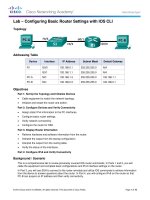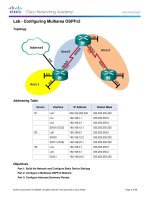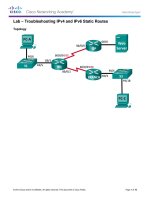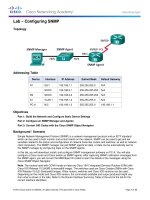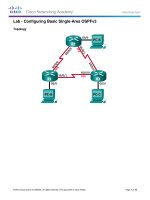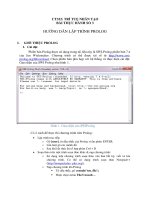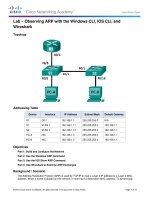8 3 3 6 lab configuring basic single area OSPFv3 kho tài liệu bách khoa
Bạn đang xem bản rút gọn của tài liệu. Xem và tải ngay bản đầy đủ của tài liệu tại đây (274.15 KB, 10 trang )
Lab - Configuring Basic Single-Area OSPFv3
Topology
© 2013 Cisco and/or its affiliates. All rights reserved. This document is Cisco Public.
Page 1 of 10
Lab - Configuring Basic Single-Area OSPFv3
Addressing Table
Device
Interface
IPv6 Address
Default Gateway
G0/0
2001:DB8:ACAD:A::1/64
FE80::1 link-local
N/A
S0/0/0 (DCE)
2001:DB8:ACAD:12::1/64
FE80::1 link-local
N/A
S0/0/1
2001:DB8:ACAD:13::1/64
FE80::1 link-local
N/A
G0/0
2001:DB8:ACAD:B::2/64
FE80::2 link-local
N/A
S0/0/0
2001:DB8:ACAD:12::2/64
FE80::2 link-local
N/A
S0/0/1 (DCE)
2001:DB8:ACAD:23::2/64
FE80::2 link-local
N/A
G0/0
2001:DB8:ACAD:C::3/64
FE80::3 link-local
N/A
S0/0/0 (DCE)
2001:DB8:ACAD:13::3/64
FE80::3 link-local
N/A
S0/0/1
2001:DB8:ACAD:23::3/64
FE80::3 link-local
N/A
PC-A
NIC
2001:DB8:ACAD:A::A/64
FE80::1
PC-B
NIC
2001:DB8:ACAD:B::B/64
FE80::2
PC-C
NIC
2001:DB8:ACAD:C::C/64
FE80::3
R1
R2
R3
Objectives
Part 1: Build the Network and Configure Basic Device Settings
Part 2: Configure and Verify OSPFv3 Routing
Part 3: Configure OSPFv3 Passive Interfaces
Background / Scenario
Open Shortest Path First (OSPF) is a link-state routing protocol for IP networks. OSPFv2 is defined for IPv4
networks, and OSPFv3 is defined for IPv6 networks.
In this lab, you will configure the network topology with OSPFv3 routing, assign router IDs, configure passive
interfaces, and use a number of CLI commands to display and verify OSPFv3 routing information.
Note: The routers used with CCNA hands-on labs are Cisco 1941 Integrated Services Routers (ISRs) with
Cisco IOS Release 15.2(4)M3 (universalk9 image). Other routers and Cisco IOS versions can be used.
Depending on the model and Cisco IOS version, the commands available and output produced might vary
from what is shown in the labs. Refer to the Router Interface Summary Table at the end of this lab for the
correct interface identifiers.
© 2013 Cisco and/or its affiliates. All rights reserved. This document is Cisco Public.
Page 2 of 10
Lab - Configuring Basic Single-Area OSPFv3
Note: Make sure that the routers have been erased and have no startup configurations. If you are unsure,
contact your instructor.
Required Resources
3 Routers (Cisco 1941 with Cisco IOS Release 15.2(4)M3 universal image or comparable)
3 PCs (Windows 7, Vista, or XP with terminal emulation program, such as Tera Term)
Console cables to configure the Cisco IOS devices via the console ports
Ethernet and serial cables as shown in the topology
Part 1: Build the Network and Configure Basic Device Settings
In Part 1, you will set up the network topology and configure basic settings on the PC hosts and routers.
Step 1: Cable the network as shown in the topology.
Step 2: Initialize and reload the routers as necessary.
Step 3: Configure basic settings for each router.
a. Disable DNS lookup.
b. Configure device name as shown in the topology.
c.
Assign class as the privileged EXEC password.
d. Assign cisco as the vty password.
e. Configure a MOTD banner to warn users that unauthorized access is prohibited.
f.
Configure logging synchronous for the console line.
g. Encrypt plain text passwords.
h. Configure the IPv6 unicast and link-local addresses listed in the Addressing Table for all interfaces.
i.
Enable IPv6 unicast routing on each router.
j.
Copy the running configuration to the startup configuration.
Step 4: Configure PC hosts.
Step 5: Test connectivity.
The routers should be able to ping one another, and each PC should be able to ping its default gateway. The
PCs are unable to ping other PCs until OSPFv3 routing is configured. Verify and troubleshoot if necessary.
Part 2: Configure OSPFv3 Routing
In Part 2, you will configure OSPFv3 routing on all routers in the network and then verify that routing tables
are updated correctly.
Step 1: Assign router IDs.
OSPFv3 continues to use a 32 bit address for the router ID. Because there are no IPv4 addresses configured
on the routers, you will manually assign the router ID using the router-id command.
© 2013 Cisco and/or its affiliates. All rights reserved. This document is Cisco Public.
Page 3 of 10
Lab - Configuring Basic Single-Area OSPFv3
a. Issue the ipv6 router ospf command to start an OSPFv3 process to the router.
R1(config)# ipv6 router ospf 1
Note: The OSPF process ID is kept locally and has no meaning to other routers on the network.
b. Assign the OSPFv3 router ID 1.1.1.1 to the R1.
R1(config-rtr)# router-id 1.1.1.1
c.
Start the OSPFv3 routing process and assign a router ID of 2.2.2.2 to R2 and a router ID of 3.3.3.3 to R3.
d. Issue the show ipv6 ospf command to verify the router IDs on all routers.
R2# show ipv6 ospf
Routing Process "ospfv3 1" with ID 2.2.2.2
Event-log enabled, Maximum number of events: 1000, Mode: cyclic
Router is not originating router-LSAs with maximum metric
<output omitted>
Step 2: Configure OSPFv6 on R1.
With IPv6, it is common to have multiple IPv6 addresses configured on an interface. The network statement
has been eliminated in OSPFv3. OSPFv3 routing is enabled at the interface level instead.
a. Issue the ipv6 ospf 1 area 0 command for each interface on R1 that is to participate in OSPFv3 routing.
R1(config)# interface g0/0
R1(config-if)# ipv6 ospf 1 area 0
R1(config-if)# interface s0/0/0
R1(config-if)# ipv6 ospf 1 area 0
R1(config-if)# interface s0/0/1
R1(config-if)# ipv6 ospf 1 area 0
Note: The process ID must match the process ID you used in Step1a.
b. Assign the interfaces on R2 and R3 to OSPFv3 area 0. You should see neighbor adjacency messages
display when adding the interfaces to area 0.
R1#
*Mar 19
LOADING
R1#
*Mar 19
LOADING
22:14:43.251: %OSPFv3-5-ADJCHG: Process 1, Nbr 2.2.2.2 on Serial0/0/0 from
to FULL, Loading Done
22:14:46.763: %OSPFv3-5-ADJCHG: Process 1, Nbr 3.3.3.3 on Serial0/0/1 from
to FULL, Loading Done
Step 3: Verify OSPFv3 neighbors.
Issue the show ipv6 ospf neighbor command to verify that the router has formed an adjacency with its
neighboring routers. If the router ID of the neighboring router is not displayed, or if its state does not show as
FULL, the two routers have not formed an OSPF adjacency.
R1# show ipv6 ospf neighbor
OSPFv3 Router with ID (1.1.1.1) (Process ID 1)
Neighbor ID
3.3.3.3
2.2.2.2
Pri
0
0
State
FULL/
FULL/
-
Dead Time
00:00:39
00:00:36
© 2013 Cisco and/or its affiliates. All rights reserved. This document is Cisco Public.
Interface ID
6
6
Interface
Serial0/0/1
Serial0/0/0
Page 4 of 10
Lab - Configuring Basic Single-Area OSPFv3
Step 4: Verify OSPFv3 protocol settings.
The show ipv6 protocols command is a quick way to verify vital OSPFv3 configuration information, including
the OSPF process ID, the router ID, and the interfaces enabled for OSPFv3.
R1# show ipv6 protocols
IPv6 Routing Protocol is "connected"
IPv6 Routing Protocol is "ND"
IPv6 Routing Protocol is "ospf 1"
Router ID 1.1.1.1
Number of areas: 1 normal, 0 stub, 0 nssa
Interfaces (Area 0):
Serial0/0/1
Serial0/0/0
GigabitEthernet0/0
Redistribution:
None
Step 5: Verify OSPFv3 interfaces.
a. Issue the show ipv6 ospf interface command to display a detailed list for every OSPF-enabled interface.
R1# show ipv6 ospf interface
Serial0/0/1 is up, line protocol is up
Link Local Address FE80::1, Interface ID 7
Area 0, Process ID 1, Instance ID 0, Router ID 1.1.1.1
Network Type POINT_TO_POINT, Cost: 64
Transmit Delay is 1 sec, State POINT_TO_POINT
Timer intervals configured, Hello 10, Dead 40, Wait 40, Retransmit 5
Hello due in 00:00:05
Graceful restart helper support enabled
Index 1/3/3, flood queue length 0
Next 0x0(0)/0x0(0)/0x0(0)
Last flood scan length is 1, maximum is 1
Last flood scan time is 0 msec, maximum is 0 msec
Neighbor Count is 1, Adjacent neighbor count is 1
Adjacent with neighbor 3.3.3.3
Suppress hello for 0 neighbor(s)
Serial0/0/0 is up, line protocol is up
Link Local Address FE80::1, Interface ID 6
Area 0, Process ID 1, Instance ID 0, Router ID 1.1.1.1
Network Type POINT_TO_POINT, Cost: 64
Transmit Delay is 1 sec, State POINT_TO_POINT
Timer intervals configured, Hello 10, Dead 40, Wait 40, Retransmit 5
Hello due in 00:00:00
Graceful restart helper support enabled
Index 1/2/2, flood queue length 0
Next 0x0(0)/0x0(0)/0x0(0)
Last flood scan length is 1, maximum is 2
Last flood scan time is 0 msec, maximum is 0 msec
Neighbor Count is 1, Adjacent neighbor count is 1
© 2013 Cisco and/or its affiliates. All rights reserved. This document is Cisco Public.
Page 5 of 10
Lab - Configuring Basic Single-Area OSPFv3
Adjacent with neighbor 2.2.2.2
Suppress hello for 0 neighbor(s)
GigabitEthernet0/0 is up, line protocol is up
Link Local Address FE80::1, Interface ID 3
Area 0, Process ID 1, Instance ID 0, Router ID 1.1.1.1
Network Type BROADCAST, Cost: 1
Transmit Delay is 1 sec, State DR, Priority 1
Designated Router (ID) 1.1.1.1, local address FE80::1
No backup designated router on this network
Timer intervals configured, Hello 10, Dead 40, Wait 40, Retransmit 5
Hello due in 00:00:03
Graceful restart helper support enabled
Index 1/1/1, flood queue length 0
Next 0x0(0)/0x0(0)/0x0(0)
Last flood scan length is 0, maximum is 0
Last flood scan time is 0 msec, maximum is 0 msec
Neighbor Count is 0, Adjacent neighbor count is 0
Suppress hello for 0 neighbor(s)
b. To display a summary of OSPFv3-enabled interfaces, issue the show ipv6 ospf interface brief
command.
R1# show ipv6 ospf interface brief
Interface
Se0/0/1
Se0/0/0
Gi0/0
PID
1
1
1
Area
0
0
0
Intf ID
7
6
3
Cost
64
64
1
State
P2P
P2P
DR
Nbrs F/C
1/1
1/1
0/0
Step 6: Verify the IPv6 routing table.
Issue the show ipv6 route command to verify that all networks are appearing in the routing table.
R2# show ipv6 route
IPv6 Routing Table - default - 10 entries
Codes: C - Connected, L - Local, S - Static, U - Per-user Static route
B - BGP, R - RIP, I1 - ISIS L1, I2 - ISIS L2
IA - ISIS interarea, IS - ISIS summary, D - EIGRP, EX - EIGRP external
ND - ND Default, NDp - ND Prefix, DCE - Destination, NDr - Redirect
O - OSPF Intra, OI - OSPF Inter, OE1 - OSPF ext 1, OE2 - OSPF ext 2
ON1 - OSPF NSSA ext 1, ON2 - OSPF NSSA ext 2
O
2001:DB8:ACAD:A::/64 [110/65]
via FE80::1, Serial0/0/0
C
2001:DB8:ACAD:B::/64 [0/0]
via GigabitEthernet0/0, directly connected
L
2001:DB8:ACAD:B::2/128 [0/0]
via GigabitEthernet0/0, receive
O
2001:DB8:ACAD:C::/64 [110/65]
via FE80::3, Serial0/0/1
C
2001:DB8:ACAD:12::/64 [0/0]
via Serial0/0/0, directly connected
L
2001:DB8:ACAD:12::2/128 [0/0]
via Serial0/0/0, receive
© 2013 Cisco and/or its affiliates. All rights reserved. This document is Cisco Public.
Page 6 of 10
Lab - Configuring Basic Single-Area OSPFv3
O
C
L
L
2001:DB8:ACAD:13::/64 [110/128]
via FE80::3, Serial0/0/1
via FE80::1, Serial0/0/0
2001:DB8:ACAD:23::/64 [0/0]
via Serial0/0/1, directly connected
2001:DB8:ACAD:23::2/128 [0/0]
via Serial0/0/1, receive
FF00::/8 [0/0]
via Null0, receive
What command would you use to only see the OSPF routes in the routing table?
Step 7: Verify end-to-end connectivity.
Each PC should be able to ping the other PCs in the topology. Verify and troubleshoot if necessary.
Note: It may be necessary to disable the PC firewall to ping between PCs.
Part 3: Configure OSPFv3 Passive Interfaces
The passive-interface command prevents routing updates from being sent through the specified router
interface. This is commonly done to reduce traffic on the LANs as they do not need to receive dynamic routing
protocol communication. In Part 3, you will use the passive-interface command to configure a single
interface as passive. You will also configure OSPFv3 so that all interfaces on the router are passive by
default, and then enable OSPF routing advertisements on selected interfaces.
Step 1: Configure a passive interface.
a. Issue the show ipv6 ospf interface g0/0 command on R1. Notice the timer indicating when the next
Hello packet is expected. Hello packets are sent every 10 seconds and are used between OSPF routers
to verify that their neighbors are up.
R1# show ipv6 ospf interface g0/0
GigabitEthernet0/0 is up, line protocol is up
Link Local Address FE80::1, Interface ID 3
Area 0, Process ID 1, Instance ID 0, Router ID 1.1.1.1
Network Type BROADCAST, Cost: 1
Transmit Delay is 1 sec, State DR, Priority 1
Designated Router (ID) 1.1.1.1, local address FE80::1
No backup designated router on this network
Timer intervals configured, Hello 10, Dead 40, Wait 40, Retransmit 5
Hello due in 00:00:05
Graceful restart helper support enabled
Index 1/1/1, flood queue length 0
Next 0x0(0)/0x0(0)/0x0(0)
Last flood scan length is 0, maximum is 0
Last flood scan time is 0 msec, maximum is 0 msec
Neighbor Count is 0, Adjacent neighbor count is 0
Suppress hello for 0 neighbor(s)
b. Issue the passive-interface command to change the G0/0 interface on R1 to passive.
R1(config)# ipv6 router ospf 1
R1(config-rtr)# passive-interface g0/0
© 2013 Cisco and/or its affiliates. All rights reserved. This document is Cisco Public.
Page 7 of 10
Lab - Configuring Basic Single-Area OSPFv3
c.
Re-issue the show ipv6 ospf interface g0/0 command to verify that G0/0 is now passive.
R1# show ipv6 ospf interface g0/0
GigabitEthernet0/0 is up, line protocol is up
Link Local Address FE80::1, Interface ID 3
Area 0, Process ID 1, Instance ID 0, Router ID 1.1.1.1
Network Type BROADCAST, Cost: 1
Transmit Delay is 1 sec, State WAITING, Priority 1
No designated router on this network
No backup designated router on this network
Timer intervals configured, Hello 10, Dead 40, Wait 40, Retransmit 5
No Hellos (Passive interface)
Wait time before Designated router selection 00:00:34
Graceful restart helper support enabled
Index 1/1/1, flood queue length 0
Next 0x0(0)/0x0(0)/0x0(0)
Last flood scan length is 0, maximum is 0
Last flood scan time is 0 msec, maximum is 0 msec
Neighbor Count is 0, Adjacent neighbor count is 0
Suppress hello for 0 neighbor(s)
d. Issue the show ipv6 route ospf command on R2 and R3 to verify that a route to the
2001:DB8:ACAD:A::/64 network is still available.
R2# show ipv6 route ospf
IPv6 Routing Table - default - 10 entries
Codes: C - Connected, L - Local, S - Static, U - Per-user Static route
B - BGP, R - RIP, I1 - ISIS L1, I2 - ISIS L2
IA - ISIS interarea, IS - ISIS summary, D - EIGRP, EX - EIGRP external
ND - ND Default, NDp - ND Prefix, DCE - Destination, NDr - Redirect
O - OSPF Intra, OI - OSPF Inter, OE1 - OSPF ext 1, OE2 - OSPF ext 2
ON1 - OSPF NSSA ext 1, ON2 - OSPF NSSA ext 2
O
2001:DB8:ACAD:A::/64 [110/65]
via FE80::1, Serial0/0/0
O
2001:DB8:ACAD:C::/64 [110/65]
via FE80::3, Serial0/0/1
O
2001:DB8:ACAD:13::/64 [110/128]
via FE80::3, Serial0/0/1
via FE80::1, Serial0/0/0
Step 2: Set passive interface as the default on the router.
a. Issue the passive-interface default command on R2 to set the default for all OSPFv3 interfaces as
passive.
R2(config)# ipv6 router ospf 1
R2(config-rtr)# passive-interface default
b. Issue the show ipv6 ospf neighbor command on R1. After the dead timer expires, R2 is no longer listed
as an OSPF neighbor.
R1# show ipv6 ospf neighbor
OSPFv3 Router with ID (1.1.1.1) (Process ID 1)
© 2013 Cisco and/or its affiliates. All rights reserved. This document is Cisco Public.
Page 8 of 10
Lab - Configuring Basic Single-Area OSPFv3
Neighbor ID
3.3.3.3
c.
Pri
0
State
FULL/
-
Dead Time
00:00:37
Interface ID
6
Interface
Serial0/0/1
On R2, issue the show ipv6 ospf interface s0/0/0 command to view the OSPF status of interface S0/0/0.
R2# show ipv6 ospf interface s0/0/0
Serial0/0/0 is up, line protocol is up
Link Local Address FE80::2, Interface ID 6
Area 0, Process ID 1, Instance ID 0, Router ID 2.2.2.2
Network Type POINT_TO_POINT, Cost: 64
Transmit Delay is 1 sec, State POINT_TO_POINT
Timer intervals configured, Hello 10, Dead 40, Wait 40, Retransmit 5
No Hellos (Passive interface)
Graceful restart helper support enabled
Index 1/2/2, flood queue length 0
Next 0x0(0)/0x0(0)/0x0(0)
Last flood scan length is 2, maximum is 3
Last flood scan time is 0 msec, maximum is 0 msec
Neighbor Count is 0, Adjacent neighbor count is 0
Suppress hello for 0 neighbor(s)
d. If all OSPFv3 interfaces on R2 are passive, then no routing information is being advertised. If this is the
case, then R1 and R3 should no longer have a route to the 2001:DB8:ACAD:B::/64 network. You can
verify this by using the show ipv6 route command.
e. Change S0/0/1 on R2 by issuing the no passive-interface command, so that it sends and receives
OSPFv3 routing updates. After entering this command, an informational message displays stating that a
neighbor adjacency has been established with R3.
R2(config)# ipv6 router ospf 1
R2(config-rtr)# no passive-interface s0/0/1
*Apr 8 19:21:57.939: %OSPFv3-5-ADJCHG: Process 1, Nbr 3.3.3.3 on Serial0/0/1
from LOADING to FULL, Loading Done
f.
Re-issue the show ipv6 route and show ipv6 ospf neighbor commands on R1 and R3, and look for a
route to the 2001:DB8:ACAD:B::/64 network.
What interface is R1 using to route to the 2001:DB8:ACAD:B::/64 network?
What is the accumulated cost metric for the 2001:DB8:ACAD:B::/64 network on R1?
Does R2 show up as an OSPFv3 neighbor on R1?
Does R2 show up as an OSPFv3 neighbor on R3?
What does this information tell you?
g. On R2, issue the no passive-interface S0/0/0 command to allow OSPFv3 routing updates to be
advertised on that interface.
h. Verify that R1 and R2 are now OSPFv3 neighbors.
© 2013 Cisco and/or its affiliates. All rights reserved. This document is Cisco Public.
Page 9 of 10
Lab - Configuring Basic Single-Area OSPFv3
Reflection
1. If the OSPFv6 configuration for R1 had a process ID of 1, and the OSPFv3 configuration for R2 had a process
ID of 2, can routing information be exchanged between the two routers? Why?
2. What may have been the reasoning for removing the network command in OSPFv3?
Router Interface Summary Table
Router Interface Summary
Router Model
Ethernet Interface #1
Ethernet Interface #2
Serial Interface #1
Serial Interface #2
1800
Fast Ethernet 0/0
(F0/0)
Fast Ethernet 0/1
(F0/1)
Serial 0/0/0 (S0/0/0)
Serial 0/0/1 (S0/0/1)
1900
Gigabit Ethernet 0/0
(G0/0)
Gigabit Ethernet 0/1
(G0/1)
Serial 0/0/0 (S0/0/0)
Serial 0/0/1 (S0/0/1)
2801
Fast Ethernet 0/0
(F0/0)
Fast Ethernet 0/1
(F0/1)
Serial 0/1/0 (S0/1/0)
Serial 0/1/1 (S0/1/1)
2811
Fast Ethernet 0/0
(F0/0)
Fast Ethernet 0/1
(F0/1)
Serial 0/0/0 (S0/0/0)
Serial 0/0/1 (S0/0/1)
2900
Gigabit Ethernet 0/0
(G0/0)
Gigabit Ethernet 0/1
(G0/1)
Serial 0/0/0 (S0/0/0)
Serial 0/0/1 (S0/0/1)
Note: To find out how the router is configured, look at the interfaces to identify the type of router and how many
interfaces the router has. There is no way to effectively list all the combinations of configurations for each router
class. This table includes identifiers for the possible combinations of Ethernet and Serial interfaces in the device.
The table does not include any other type of interface, even though a specific router may contain one. An
example of this might be an ISDN BRI interface. The string in parenthesis is the legal abbreviation that can be
used in Cisco IOS commands to represent the interface.
© 2013 Cisco and/or its affiliates. All rights reserved. This document is Cisco Public.
Page 10 of 10


